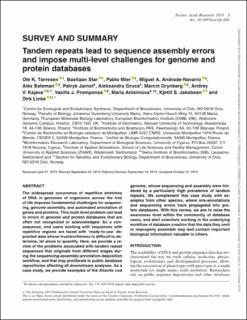Please use this identifier to cite or link to this item:
https://doi.org/10.21256/zhaw-18481Full metadata record
| DC Field | Value | Language |
|---|---|---|
| dc.contributor.author | Tørresen, Ole K | - |
| dc.contributor.author | Star, Bastiaan | - |
| dc.contributor.author | Mier, Pablo | - |
| dc.contributor.author | Andrade-Navarro, Miguel A | - |
| dc.contributor.author | Bateman, Alex | - |
| dc.contributor.author | Jarnot, Patryk | - |
| dc.contributor.author | Gruca, Aleksandra | - |
| dc.contributor.author | Grynberg, Marcin | - |
| dc.contributor.author | Kajava, Andrey V | - |
| dc.contributor.author | Promponas, Vasilis J | - |
| dc.contributor.author | Anisimova, Maria | - |
| dc.contributor.author | Jakobsen, Kjetill S | - |
| dc.contributor.author | Linke, Dirk | - |
| dc.date.accessioned | 2019-10-18T09:00:29Z | - |
| dc.date.available | 2019-10-18T09:00:29Z | - |
| dc.date.issued | 2019-10-04 | - |
| dc.identifier.issn | 0305-1048 | de_CH |
| dc.identifier.issn | 1362-4962 | de_CH |
| dc.identifier.uri | https://digitalcollection.zhaw.ch/handle/11475/18481 | - |
| dc.description.abstract | The widespread occurrence of repetitive stretches of DNA in genomes of organisms across the tree of life imposes fundamental challenges for sequencing, genome assembly, and automated annotation of genes and proteins. This multi-level problem can lead to errors in genome and protein databases that are often not recognized or acknowledged. As a consequence, end users working with sequences with repetitive regions are faced with 'ready-to-use' deposited data whose trustworthiness is difficult to determine, let alone to quantify. Here, we provide a review of the problems associated with tandem repeat sequences that originate from different stages during the sequencing-assembly-annotation-deposition workflow, and that may proliferate in public database repositories affecting all downstream analyses. As a case study, we provide examples of the Atlantic cod genome, whose sequencing and assembly were hindered by a particularly high prevalence of tandem repeats. We complement this case study with examples from other species, where misannotations and sequencing errors have propagated into protein databases. With this review, we aim to raise the awareness level within the community of database users, and alert scientists working in the underlying workflow of database creation that the data they omit or improperly assemble may well contain important biological information valuable to others. | de_CH |
| dc.language.iso | en | de_CH |
| dc.publisher | Oxford University Press | de_CH |
| dc.relation.ispartof | Nucleic Acids Research | de_CH |
| dc.rights | http://creativecommons.org/licenses/by/4.0/ | de_CH |
| dc.subject | Genomics | de_CH |
| dc.subject | Bioinformatics | de_CH |
| dc.subject.ddc | 572: Biochemie | de_CH |
| dc.title | Tandem repeats lead to sequence assembly errors and impose multi-level challenges for genome and protein databases | de_CH |
| dc.type | Beitrag in wissenschaftlicher Zeitschrift | de_CH |
| dcterms.type | Text | de_CH |
| zhaw.departement | Life Sciences und Facility Management | de_CH |
| zhaw.organisationalunit | Institut für Computational Life Sciences (ICLS) | de_CH |
| dc.identifier.doi | 10.1093/nar/gkz841 | de_CH |
| dc.identifier.doi | 10.21256/zhaw-18481 | - |
| dc.identifier.pmid | 31584084 | de_CH |
| zhaw.funding.eu | info:eu-repo/grantAgreement/EC/H2020/823886//Repeat protein Function Refinement, Annotation and Classification of Topologies/REFRACT | de_CH |
| zhaw.issue | 21 | de_CH |
| zhaw.originated.zhaw | Yes | de_CH |
| zhaw.pages.end | 11006 | de_CH |
| zhaw.pages.start | 10994 | de_CH |
| zhaw.publication.status | publishedVersion | de_CH |
| zhaw.volume | 47 | de_CH |
| zhaw.publication.review | Peer review (Publikation) | de_CH |
| zhaw.funding.snf | 174836 | de_CH |
| zhaw.webfeed | Computational Genomics | de_CH |
| zhaw.funding.zhaw | Discovering evolutionary innovations by assessing variation and natural selection in protein tandem repeats | de_CH |
| zhaw.author.additional | No | de_CH |
| Appears in collections: | Publikationen Life Sciences und Facility Management | |
Files in This Item:
| File | Description | Size | Format | |
|---|---|---|---|---|
| 2019Toerresen_tandem-repeats-lead-to-sequence-assembly-errors_NucleidAcidsResearch.pdf | 916.98 kB | Adobe PDF |  View/Open |
Show simple item record
Tørresen, O. K., Star, B., Mier, P., Andrade-Navarro, M. A., Bateman, A., Jarnot, P., Gruca, A., Grynberg, M., Kajava, A. V., Promponas, V. J., Anisimova, M., Jakobsen, K. S., & Linke, D. (2019). Tandem repeats lead to sequence assembly errors and impose multi-level challenges for genome and protein databases. Nucleic Acids Research, 47(21), 10994–11006. https://doi.org/10.1093/nar/gkz841
Tørresen, O.K. et al. (2019) ‘Tandem repeats lead to sequence assembly errors and impose multi-level challenges for genome and protein databases’, Nucleic Acids Research, 47(21), pp. 10994–11006. Available at: https://doi.org/10.1093/nar/gkz841.
O. K. Tørresen et al., “Tandem repeats lead to sequence assembly errors and impose multi-level challenges for genome and protein databases,” Nucleic Acids Research, vol. 47, no. 21, pp. 10994–11006, Oct. 2019, doi: 10.1093/nar/gkz841.
TØRRESEN, Ole K, Bastiaan STAR, Pablo MIER, Miguel A ANDRADE-NAVARRO, Alex BATEMAN, Patryk JARNOT, Aleksandra GRUCA, Marcin GRYNBERG, Andrey V KAJAVA, Vasilis J PROMPONAS, Maria ANISIMOVA, Kjetill S JAKOBSEN und Dirk LINKE, 2019. Tandem repeats lead to sequence assembly errors and impose multi-level challenges for genome and protein databases. Nucleic Acids Research. 4 Oktober 2019. Bd. 47, Nr. 21, S. 10994–11006. DOI 10.1093/nar/gkz841
Tørresen, Ole K, Bastiaan Star, Pablo Mier, Miguel A Andrade-Navarro, Alex Bateman, Patryk Jarnot, Aleksandra Gruca, et al. 2019. “Tandem Repeats Lead to Sequence Assembly Errors and Impose Multi-Level Challenges for Genome and Protein Databases.” Nucleic Acids Research 47 (21): 10994–1006. https://doi.org/10.1093/nar/gkz841.
Tørresen, Ole K., et al. “Tandem Repeats Lead to Sequence Assembly Errors and Impose Multi-Level Challenges for Genome and Protein Databases.” Nucleic Acids Research, vol. 47, no. 21, Oct. 2019, pp. 10994–1006, https://doi.org/10.1093/nar/gkz841.
Items in DSpace are protected by copyright, with all rights reserved, unless otherwise indicated.